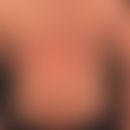Synonym(s)
HistoryThis section has been translated automatically.
from Zumbusch, 1910
DefinitionThis section has been translated automatically.
Psoriasis pustulosa generalisata (PPG) is clinically defined as: " Acquired, rarely familial (Marrakchi S et al. 2011), sterile pustulosis on "non-sacral" skin with or without associated psoriasis vulgaris, with or without systemic inflammation, which may be persistent (> 3 months) or recurrent (> 1 episode) with an individually variable (potentially life-threatening) course" (extended version of the European Consensus Statement on Phenotypes of Pustular Psoriasis). Previously, the disease was classified as a rare, severe, maximum pustular variant of psoriasis . It is now also seen as a clinical entity to be distinguished from psoriasis.
You might also be interested in
ClassificationThis section has been translated automatically.
The disease occurs in 3 clinical variants:
- Sporadic PPG without symptoms of psoriasis vulgaris
- Sporadic PPG with associated symptoms of psoriasis vulgaris (30% of cases)
- Familial PPG (In 2011, homozygous missense mutations in the IL36RN gene were identified in nine Tunisian families in which several members had GPP (Marrakchi S et al. 2011).
Occurrence/EpidemiologyThis section has been translated automatically.
Rare; prevalence: 0.1-0.9/100,000 inhabitants. More common in Japan than in European ethnic groups (incidence: approx. 0.7/100,000 inhabitants/Ohkawara A et al. 1996).
EtiopathogenesisThis section has been translated automatically.
Pustular psoriasis represents a different type of reaction to psoriasis vulgaris, which can occur with or without the precursor stage of psoriasis vulgaris. However, there are patients in whom both manifestations alternate. Psoriasis vulgaris can also suddenly be complicated by a pustular component (psoriasis cum pustulatione).
Trigger factors: Trigger factors for generalized pustular psoriasis include bacterial and viral(Epstein-Barr virus infections) infections, medication (antihypertensives, terbinafine, chloroquine - see also hydroxychloroquine-induced"generalized pustular figured erythema"), pregnancy (see also Impetigo herpetiformis) or sudden withdrawal of systemic glucocorticoid therapy. In rare cases, a pustular paradoxical reaction has been observed during therapy with biologics (P Weisenseel 2016).
Genetics: Rare cases of familial PPG are associated with loss-of-function mutations of the interleukin-36 receptor gene(IL-36RN gene), which encodes the receptor protein interleukin-36a. Interleukin-36a is an antagonist of 3 proinflammatory interleukins of the interleukin-1 family (IL-36alpha, IL-36beta, IL-36gamma). The dysfunction of interleukin-36a leads to a predominance of pro-inflammatory cytokines and inflammatory reactions. Interleukin-36gamma stimulates the production of IL8 and pro-Il-36 gamma, while genes coding for epidermal differentiation (e.g. see corneodesmosin gene below) are downregulated, which is associated with a strong infiltration of neutrophil granulocytes. The pro-Il-36 is cleaved into its mature form by a neutrophil protease. This then suppresses conedxesmosin and leads to exfoliation and pustule formation.
Remark: Mössner et al. found biallelic and monoallelic IL36RN mutations in 15 (24%) GPP patients and in 5 (8%) patients with GPP+psoriasis, respectively. The only significant genotype-phenotype correlation observed in IL36RN mutation carriers according to these authors is early age at disease onset.
Mutations in the IL36RN gene can also be detected in exfoliatio areata linguae .
Furthermore, associations with rare CARD14 or AP1S3 variants have been detected in 15 % of IL36RN mutation carriers (Mössner R et al. 2018)
The following gene variants are occasionally found in PGG:
Note: The CARD14 mutants lead to destabilization and malfunction of the pattern recognition receptor TLR-3(Toll-like receptor 3). Toll-like receptors are used to recognize so-called "Pathogen Associated Molecular Patterns"(PAMPs).
ManifestationThis section has been translated automatically.
Adults appearing after the 40th LJ. Rarely children.
LocalizationThis section has been translated automatically.
The entire integument with a preference for the trunk and extremities, oral mucosa and the mucous membranes of the upper respiratory tract and genital mucous membranes can also be affected.
Acute stomatitis with fine-lamellar, wipeable circinar or oval plaques (stomatitis geographica, stomatitis areata migrans) is found in the oral mucosa. There are findings on the tongue that can be morphologically classified as exfoliatio areata linguae.
ClinicThis section has been translated automatically.
Acute erythema and oedema occurring "overnight", accompanied by high fever and a severe feeling of illness, extending to complete or incomplete erythroderma with countless white or yellow, sterile pustules, either isolated or confluent to form pus lakes. The pustules burst within a short time, dry up or leave behind extensive weeping areas.
If left untreated, an intermittent course is typical, which can last for weeks or months. The frequency of flare-ups varies and can last for hours or days.
There may be whitish or gray, veil-like, exfoliating plaques in the area of the oral mucosa (exfoliatio areata linguae).
Psoriasis pusutlosa generalisata can be associated with Crohn's disease (Canbay A et al. 2001).
Depending on the extent and severity of the lesions, a distinction is made between different degrees of severity of generalized pustular psoriasis, which can be determined according to the following indices:
- Generalized Pustular Prosiasis Area and Severity Index/GPPASI): Depending on the severity, this index ranges from 0 (minimal infestation) to 72 (most severe infestation).
- Generalized Pustular Psoriasis Physician Global Assessment (GPPGA): This index evaluates the severity of the individual efflorescences erythema, scaling, pustules from severity 0 to 4, then the mean value is calculated.
LaboratoryThis section has been translated automatically.
BSG > 40 mm/hour; CRP > 50mg/l; leukocytosis mostly > 12,000/ul; neutrophilia often >80%; rarely hypoparathyroidism.
HistologyThis section has been translated automatically.
Superficial perivascular and interstitial lymphocytic and leukocytic dermatitis with epidermotropy and spongiform, subcorneal or highly intraepithelial pustules, see also Kogoj pustules.
Differential diagnosisThis section has been translated automatically.
Subcorneal pustulosis (Sneddon-Wilkinson): Rare, chronic, recurrent disease with formation of strictly subcorneal, sterile pustules. Nosology is controversial.
Pustulosis, acute generalized exanthematous (AGEP): Acute, generalized, usually febrile, non-follicular, sterile, pustular exanthema occurring in association with infections and/or medication, but also spontaneously, always associated with marked systemic leukocytosis and neutrophilia, and with a great tendency to heal spontaneously. There is no association with psoriasis vulgaris.
Generalized pustular figured erythema: Acute, rare, clinically severe, generalized pustular disease that has generally been classified as AGEP in the past. More than 20 cases of GPFE due to hydroxychloroquine have been described in the medical literature.
Toxic pustuloderma: no longer considered as an entity but as AGEP
Impetigo herpetiformis: is regarded as a pregnancy-induced variant of pustular psoriasis generalisata. Clinically there is a mostly acute, generalized pustular clinical picture.
Complication(s)(associated diseasesThis section has been translated automatically.
Bronchopneumonia, hepatic metabolic disorders, iron deficiency, renal insufficiency.
General therapyThis section has been translated automatically.
- The range of clinical manifestations is wide. The general therapeutic measures vary accordingly.
- PPG must be classified as a life-threatening disease.
- In severe PPG, intensive care conditions apply in appropriately equipped therapy units.
- Discontinuation of possible provoking medication.
- Treatment of bacterial infections, focus search and remediation.
- General measures: isolation of the patient, protective clothing/mouth protection for medical/nursing staff, monitoring, sufficient volume supply, fluid balancing, heat supply, exact temperature control, moisture supply in the room air, special bed for decubitus prophylaxis/position on Metalline foil, bladder catheter, documentation of findings.
Remember! Check intravenous accesses regularly and change them daily (high risk of contamination)!
External therapyThis section has been translated automatically.
Applysulfadiazine-silver cream(e.g. Flammazine) thinly to affected areas (erosions). Wound debridement, detach necrotic skin sections; puncture and open blisters sterilely. Gauze mesh on erosive wound areas if necessary with antibiotic additive (e.g. bactigrass). Oral hygiene with astringent liquids (e.g. rp. 255 , Hexoral Lsg.). Eye hygiene several times a day with disinfecting and astringent eye drops (e.g. Solan eye drops). In addition, apply eye ointment containing dexpanthenol in a thick layer. Loosen adhesions with stick swab.
Treat pustular skin briefly with potent glucocorticoid such as 0.1% betamethasone rp. 029 or 0.05% clobetasol cream rp. 054 . In groins and axillae, 0.5% hydrocortisone zinc cream rp. 127 . After resolution of pustular relapse activity, transition to bland local therapy with hydrophilic ointments (e.g., Ungt. emulsif. aq.).
Radiation therapyThis section has been translated automatically.
Internal therapyThis section has been translated automatically.
- There are currently no guidelines for treatment. It is recommended to use conventional immunosuppressants (ciclosporin, methotrexate, corticosteroids) or retinoids in the acute phase, possibly in combination with phototherapy (PUVA, narrow-band UVB), or to start initiation with biologicals such as anti-TNF-alpha, anti-IL-17 or anti-IL-12/IL-23/IL-23p19, depending on the patient's situation and the practitioner's experience.
- Since January 2023, the monoclonal antibody spesolimab (Spevigo®) has been approved for the treatment of acute GPP relapse. Spesolimab inhibits the human IL-36 receptor in a highly specific manner so that the proinflammatory IL-36 cytokine pathway is blocked (Choon SE et al. 2021). Including rapid remission of skin and systemic symptoms: 50% of patients pustule-free after just 8 days, 71% at week 12. Dosage: 900 mg as an infusion over a period of 90 minutes during an attack. In case of persistence 2nd dose in identical amount. Remark: The preparation has since been withdrawn from the market.
Another IL-36R antibody (imsidolimab) shows promising study results.
A successful treatment report exists for the IL-23p19 antibody risankizumab (Heyer S et al. 2022)
In severe cases, fully balanced parenteral nutrition in the first few days. Scheme with daily application of colloidal solution (1 ml/kg bw x affected KO), electrolyte solution (physiological saline solution 1 ml/kg bw x affected KO).
- Antibiosis according to antibiogram.
- If the situation is stable, switch to a high-calorie liquid diet (e.g. Meritene). Later diet with strained food; no spices, no fruit acids.
- Treatment options for psoriasis vulgaris are often adopted: acitretin, ciclosporin, methotrexate, short-term steroids, also UV radiation, see above.
-
Successes with acitretin (neotigason) 0.5-1.0 mg/kg bw/day p.o. have been reported (note: the therapeutic principle has not been sufficiently proven!). After the initiation phase reduction to the lowest possible maintenance dose according to the clinic. If therapy fails, methotrexate (e.g. MTX) or fumaric acid ester (Fumaderm). Priority is given to methotrexate 15 - 25 mg/week i.v. due to faster onset of action!
Alternatively, a combination of methotrexate and fumaric acid esters may be possible. After the acute flare-up has subsided, therapy can be continued with fumaric acid esters alone if necessary.
- Successes with infliximab (off-label use!) have been described in individual case reports. See also psoriasis vulgaris below
. note! Infliximab is already included in the guidelines of the British Association of Dermatology for this indication! However, as a rapid and reliable response to therapy is absolutely essential, Infliximab is currently to be regarded as the "safe" therapy of first choice.
- Experimental and alternative: The use of interleukin-1 inhibitors (gevokizumab) led in individual cases (2 patients) to a prompt response within a 4-week period!
- Accompanying sedating antihistamine such as promethazine 75-100 mg/day p.o. (e.g. Atosil Drg.) or dimetinden 2 times/day 4 mg i.v. (e.g. Fenistil).
Comment: Internal glucocorticoids are possibly contraindicated from the etiologic understanding of the disease. However, they are effective in a very acute initial period, both externally and internally (200-250 mg prednisolone i.v.) and are suitable for bridging an acute initial phase!
Progression/forecastThis section has been translated automatically.
If left untreated, an intermittent course is typical, which can last for weeks or months. The frequency of relapses varies and can last for hours or days. Life-threatening course possible, especially in older patients. In a study conducted in 2022 on Japanese patients with GPP who required hospitalization (n = 1516), a mortality rate of 4.2% was reported (Miyachi H et al. 2022)
Case report(s)This section has been translated automatically.
See illustration above
LiteratureThis section has been translated automatically.
Bachelez H (2020) Pustular Psoriasis: The Dawn of a New Era. Acta Derm Venereol 100: adv00034.
- Cassandra M et al. (2003) Childhood pustular psoriasis elicited by the streptococcal antigen: a case report and review of the literature. Pediatr Dermatol 20: 506-510
- Canbay A et al. (2001) Psoriasis pustulosa generalisata: new extraintestinal manifestation of Crohn's disease? Z Gastroenterol 39:801-805.
- Choon SE et al. (2021) Study protocol of the global Effisayil 1 Phase II, multicentre, randomized, double-blind, placebo-controlled trial of spesolimab in patients with generalized pustular psoriasis presenting with an acute flare. BMJ Open 11:e043666.
Heyer S et al. (2022) Successful therapy of acute generalized pustular psoriasis with the IL-23p19 antibody risankizumab. JDDG 20: 1362-1364.
- Hussain S et al. (2015) IL36RN mutations define a severe autoinflammatoryphenotype of generalized pustular psoriasis. J Allergy Clin Immunol 135:1067-1070
- Jiyad Z et al. (2014) Generalized pustular psoriasis associated with Epstein-Barr virus. Clin Exp Dermatol 40:146-148
- Kim HS et al. (2014) Two cases of generalized pustular psoriasis: successful treatment with infliximab. Ann Dermatol 26:787-788
- Mansouri B et al. (2014) Treatment of two patients with generalized pustular psoriasis with the interleukin-1β inhibitor gevokizumab. Br J Dermatol 173: 239-241.
Marrakchi S et al. (2011) Interleukin-36-receptor antagonist deficiency and generalized pustular psoriasis. N Engl J Med 365:620-628.
Miyachi H et al. (2022) Treatments and outcomes of generalized pustular psoriasis: A cohort of 1516 patients in a nationwide inpatient database in Japan. J Am Acad Dermatol 86:1266-1274.
Mössner R et al. (2018) The genetic basis for most patients with pustular skin disease remains elusive. Br J Dermatol 178:740-748.
Ohkawara A et al. (1996) Generalized pustular psoriasis in Japan: two distinct groups formed by differences in symptoms and genetic background. Acta Derm Venereol 76: 68-71.5.
- Setta-Kaffetzi N ET AL: (2014) AP1S3 mutations are associated with pustular psoriasis and impaired Toll-like receptor 3 trafficking. Am J Hum Genet 94:790-797.
- Shiratori T et al. (2015) IL36RN gene analysis of two Japanese patients with generalized pustular psoriasis. Int J Dermatol 54:e60-62
- Sugiura K et al. (2013) The majority of generalized pustular psoriasis without psoriasis vulgaris is caused by deficiency of interleukin-36 receptor antagonist. J Invest Dermatol 133:2514-2521
- Soltermann W (1958) Familial psoriasis pustulosa under the picture of impetigo herpetiformis; casuistic contributions to the question of the identity of psoriasis pustulosa and impetigo herpetiformis Dermatologica 116:313-30.
- Tholen S et al. (1987) Oral mucosal changes in pustular psoriasis generalisata. Dermatologist 38: 419-421
- Vogelgsang L et al (2015) Generalized pustular psoriasis: a rare entity. JDDG 13 (Suppl 1): 103
- Weißenseel P et al (2016) Pustular psoriasis. Dermatology 67: 445-453
- von Zumbusch LR (1910) Psoriasis and pustular exanthema. Arch Dermatol Syphilol (Berlin) 99: 335-346
- Reich K et al. (2022) Generalized pustular psoriasis: overview of the status quo and results of a panel discussion. J Dtsch Dermatol Ges. 20:753-771
- Navarini AA, et al. (2017) ERASPEN Network. European consensus statement on phenotypes of pustular psoriasis. J Eur Acad Dermatol Venereol. 31: 1792-1799
Incoming links (27)
Acitretin; Acrodermatitis continua suppurativa; AiKDs; Ap1s3 gene; Betamethasone valerate cream hydrophilic 0.025/0.05 or 0.1% (nrf 11.37.); CARD14 Gene; Clobetasol propionate cream hydrophilic 0.05% (nrf 11.76.); Erosive pustular dermatosis of the scalp; Etanercept; Exfoliation areata linguae; ... Show allOutgoing links (37)
Acute generalized exanthematous pustulosis; Antibiogram; Antibiotics; Antihistamines, systemic; Ap1s3 gene; CARD14 Gene; CDSN Gene; Dexpanthenol; Dimetinden; Exfoliation areata linguae; ... Show allDisclaimer
Please ask your physician for a reliable diagnosis. This website is only meant as a reference.
Images (13)
Articlecontent
- History
- Definition
- Classification
- Occurrence/Epidemiology
- Etiopathogenesis
- Manifestation
- Localization
- Clinic
- Laboratory
- Histology
- Differential diagnosis
- Complication(s)(associated diseases
- General therapy
- External therapy
- Radiation therapy
- Internal therapy
- Progression/forecast
- Case report(s)
- Literature
- References
- Authors

















